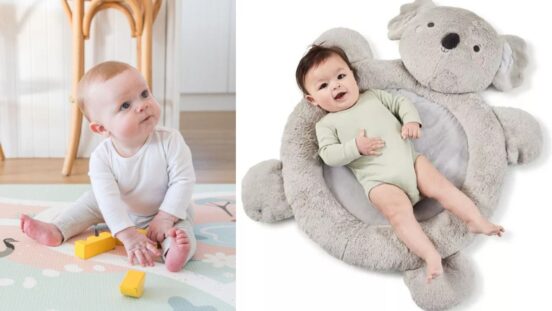The secret language of babies
What your baby is trying to tell you
So, here it is. Motherhood. You have a beautiful baby whose needs you want to meet more than your own and who is without doubt one of the most important people in your life. There’s one sticking point. She can’t always tell you what she wants and you may sometimes end up feeling like you’re having a slightly one-sided conversation.
But child and family health nurse Sharon Donaldson says your baby is always communicating with you. “She does this with her cry, and in a few other subtle forms,” says Sharon. “A newborn can differentiate between the sound of a human voice – watch the way she responds to your voice – and other sounds. Learning to pick up on the little details is rewarding, and can strengthen your bond with her.”
These signs are her secret language, or baby code. Here’s how to decipher what your little one is trying to tell you.
BONDING EYES
Your newborn will lock her eyes onto yours around the one- or two-month mark, as her focus becomes clearer. “This direct eye contact provides very meaningful communication between you and your new baby,” says Sharon. “It is often her way of showing you love, and also looking for signs of reassurance and security from you.”
HOW TO REPLY
“Look into your baby’s eyes while talking and singing to her,” says Sharon. “No matter how silly you might feel, just keep on talking. Tell her how lovely she is, what you are going to do today, what time it is… anything at all.” If your baby is looking to you for reassurance after a noise or sudden movement, as well as holding her gaze, a good soothing trick is to place your hand quite firmly on her tummy to make her feel secure.
EXCITED GURGLE
This is your baby’s way of saying, ‘Look at me!’ or ‘I like this!’ “When your baby discovers she can vocalise, she will start to ‘talk’ to you in a variety of sounds,” says Sharon. “She can become excited easily – while playing with a toy, spotting something in the corner of her eye, or simply just to gain your attention. Babies love to gurgle. It’s their happy talk.”
HOW TO REPLY
Try to respond and imitate your baby in a happy, upbeat tone. “Say, ‘Here you are’ or ‘Is this what you want?’ while offering her a toy she may be interested in,” says Sharon. “Have back-and-forth conversations in baby talk to teach your baby the give-and-take of conversation.”
HUNGRY TONGUE
Is your baby sticking out her tongue and moving it from side to side? “From birth, your baby can stick her tongue out. Usually in search of milk, but also in search of comfort,” says Sharon. And if her tongue’s sitting on the middle of her bottom lip and poking in and out, she’s showing you she’s hungry. “Your baby has a very sensitive mouth and tongue and she will move her tongue a lot more when she wants feeding,” says Sharon. “By stroking her cheek, you can encourage your baby to turn in your direction and feed.”
HOW TO REPLY
“Offer your baby a feed if it’s the right time,” says Sharon. “Depending on the age of your baby, you may be able to distract her if she’s not due for a feed. If she’s not hungry, then some comforting and cuddles may be what she’s after.”

At first you might be a bit silly having one-sided conversations but your voice is music to your little one’s ears – even if you’re reciting your shopping list!
NERVOUS CRY
Your newborn does this for various reasons, ranging from hunger to tiredness. When she reaches between six and eight months, however, a certain cry when you disappear from her sight indicates separation anxiety. “Older babies can become quite distressed when you disappear for a moment. Upon your return, she will implore you to lift her up,” says Sharon.
HOW TO REPLY
Soothe your baby, but also show her there’s nothing to worry about. “Doing things in little increments is the key,” says Sharon. “Start by leaving the room for just a couple of minutes at a time, perhaps while someone else is there. Over time you can gradually increase the amount of time you leave. She will soon begin to understand that you will always return. The classic peekaboo game is a simple form of this.”
CLEVER CLAP
From around eight months, your child will be able to clap her hands. “When your baby learns to clap her hands, she will be so excited that she’ll do it over and over again,” says Sharon. “Once she can control her hands with this action she will definitely clap more to impress you.”
HOW TO REPLY
Mirror her joy back at her by clapping yourself. “With happy, smiling eyes, show your joy, and clap together, then take turns to clap,” suggests Sharon. “Your baby’s communication skills will benefit as she learns the give and take idea of the game.” This is also a good time to start showing your baby other ‘excited’ gestures, which she can learn to mimic, such as raising her arms in joy. “It’s a good idea to make your movements slow and exaggerated. It’s easier for her to understand and copy you,” says Sharon.




